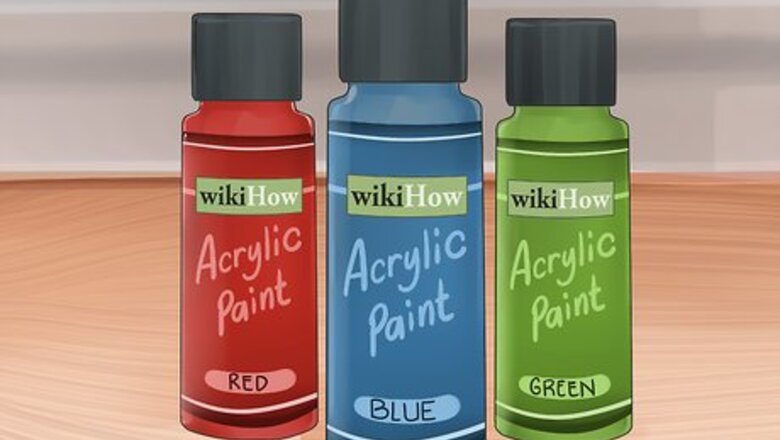
views
Using Acrylic Paints to Dye Your Shirt
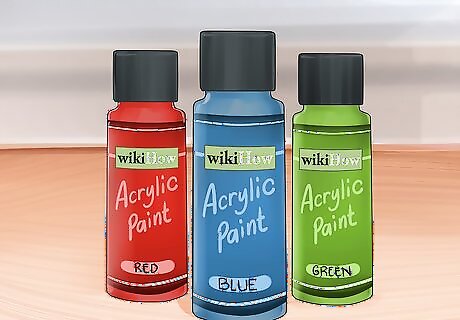
Consider tie-dyeing your shirt using acrylic paint. You can tie-dye your shirt using watered-down acrylic paint. The shirt will need to dry, but once you heat-set it by tossing it into the drier, it will be ready to be worn. This method is similar to the traditional tie-dying method, but it does not require hot water or as much preparation as the traditional method.
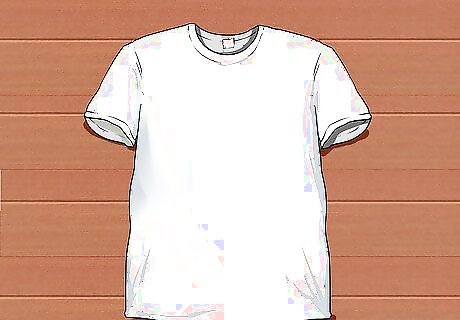
Find a white-colored shirt to dye. Although this method uses acrylic paints, which are more opaque than fabric dye, you will get the best results with a white or light-colored shirt. The paint will be watered down, so some of the shirt's original color will show through. You can tie-dye almost anything, from T-shirts to pants and skirts to even baseball caps.
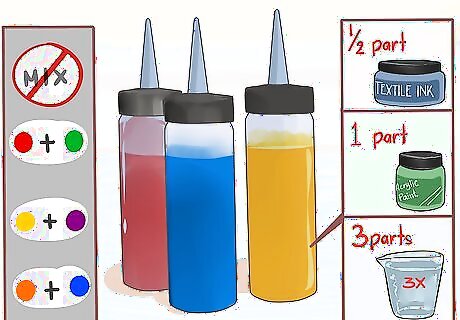
Prepare your paint. You will need ½ part fabric textile medium, 1 part paint, and 3 parts water. Pour everything into a plastic applicator bottle and shake it up to mix everything together. The fabric textile medium will prevent the paint from becoming too stiff once it has dried. Use a different applicator bottle for each color. The colors will bleed together, so avoid using contrasting colors such as red and green, blue and orange, and yellow and purple, or you will get some muddy browns in your finished piece!

Lightly mist the shirt with water. You can also dip the shirt in some water and twist it tightly to wring all of the excess water out. You want the shirt to be damp, not soaking-wet.
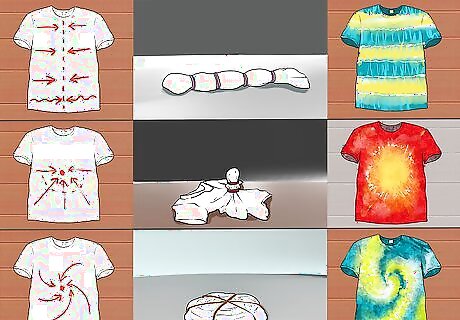
Tie rubber bands around the shirt. You can create different patterns depending on how you wrap the rubber bands around your shirt. Here are a few popular designs: Stripes are the easiest and simplest design. Simply fold your shirt up like a fan or accordion creating a sort of rope. You can do width-wise, length-wise, or even diagonally. Wrap a rubber band around one end of your "rope," then wrap another rubber band two to three inches (5.08 to 7.62 centimeters) down. Keep doing this until you reach the end of your rope. The sunburst is a circular design, with each ray or ring being a different color. Pinch the middle of your shirt and pull it towards you. Tie the end off with a rubber band. Go a little further down your shirt and tie it off with another rubber band. Keep doing this until you have a thick "rope" made out of fabric and rubber bands. The spiral is another popular design. Place your shirt down on a flat surface. Pinch the middle of your shirt and twist it. Keep twisting until you have created a spiral, or something like looks like a cinnamon roll. Wrap a large rubber band around the "bun" you have made. Then wrap another rubber band, but this time in the opposite direction, making a cross shape. You can wrap more rubber bands around your bun, sectioning it like a pizza or cake.
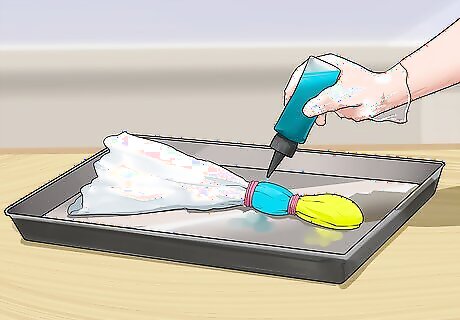
Apply the colors in the spaces between the rubber bands. Work over a container, such as a plastic container or an aluminum tray. Press the tip of the applicator against the fabric and squeeze gently. This allows the paint to absorb directly into the fabric as opposed to squirting out everywhere.
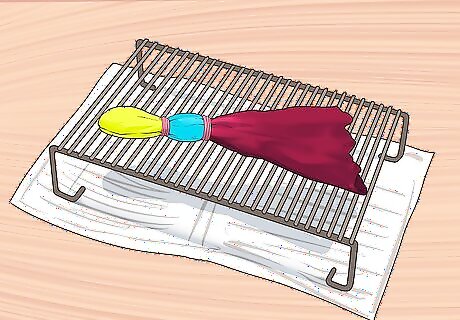
Leave the shirt on top of a wire rack and let the colors set. Place a wire rack over some paper towels, newspaper, or a baking sheet. Then, without removing the rubber bands, set the shirt down on the wire rack. This will allow any excess paint to drip down, and prevent it from pooling under your shirt. Let the shirt sit for one hour, so that the colors can set into the fabric.
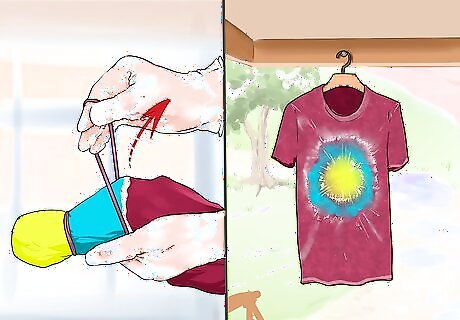
Remove the rubber bands and let the shirt hang dry. The shirt should be mostly dry by now, but the center might still be wet. Hang it up in a sunny spot until it is fully dry. This will also help relax any wrinkles. Keep in mind that the cooler or more humid it is, the longer it will take for your shirt to dry.
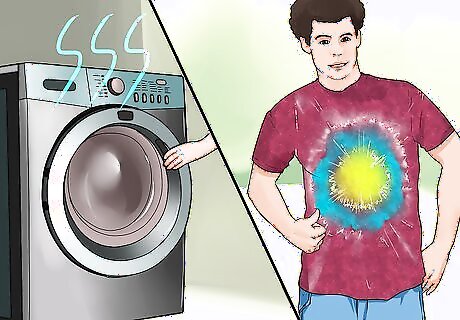
Heat set the colors. To make the colors more permanent, toss the shirt into a drier for about 15 minutes. After this, your shirt is ready to wear and wash.
Using Bleach to Dye Your Shirt
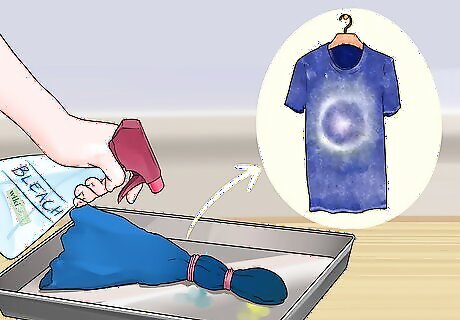
Consider reverse tie-dye. By using bleach, you can take away color from an already-colored shirt. This is known as reverse tie-dye and takes less than traditional tie-dyeing because you do not have to prepare the dyes or let the dyes cure. Adult supervision is recommended for this method.
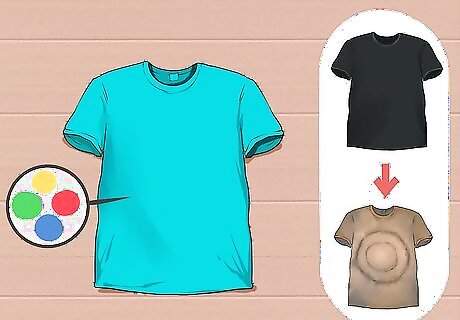
Find a colored shirt. Unlike with traditional tie-dying, you will be taking away color instead of adding it. For this, you will need a colored shirt. The bleached out areas will be lighter in color, except in the case of a black shirt—the bleached out areas will usually turn copper. The brighter color the shirt is, the more effective the bleach will be.
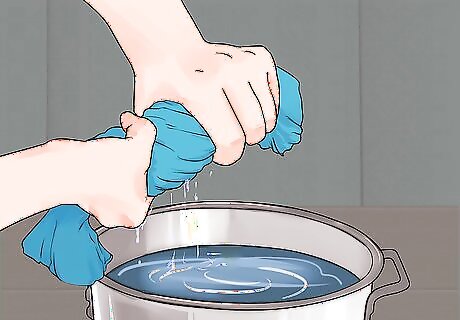
Lightly mist the shirt with water. You can also dip the shirt in some water and twist it tightly to wring all of the excess water out. You want the shirt to be damp, not soaking-wet.
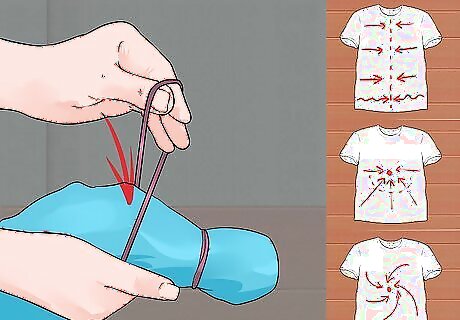
Tie rubber bands around the shirt. You can create different patterns depending on how you wrap the rubber bands around your shirt. Here are some popular designs: To create some simple stripes, fold your shirt up like a fan or accordion. You are creating a sort of rope. You can fold width-wise, length-wise, or even diagonally. Tie off one end of your rope with a rubber band. Wrap another rubber band two to three inches (5.08 to 7.62 centimeters) down from the first one. Keep doing this until you reach the end of the rope. To create a sunburst, pinch the middle of your shirt and pull it towards you. Wrap a rubber band around the end. Go a little further down the shirt and wrap another rubber band around it. Keep doing this until you have a sort of "rope." To make a spiral design, place your shirt down on a flat surface and pinch the middle. Give the shirt a small twist. Keep twisting until you have created something like looks like a cinnamon roll. Wrap a rubber band around the "bun." Then wrap another rubber band, but this time in the other direction, creating a cross. You can wrap more rubber bands around your bun, sectioning it like a pizza or cake.
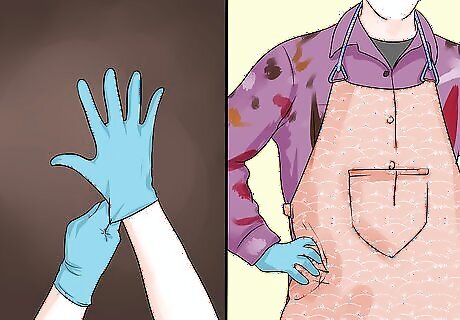
Protect yourself and your clothes. Because you will be working with bleach, you will need to protect both yourself and your clothes. Wear some gloves to protect your skin, and an apron or artist's smock to protect your clothes. You can also wear some old clothes that you do not mind potentially getting ruined or stained.
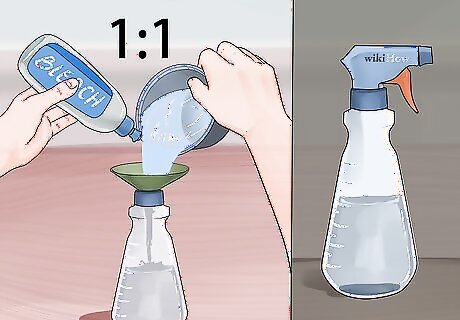
Prepare your bleach solution. You will need one part bleach and one part water. Pour both into a spray bottle.
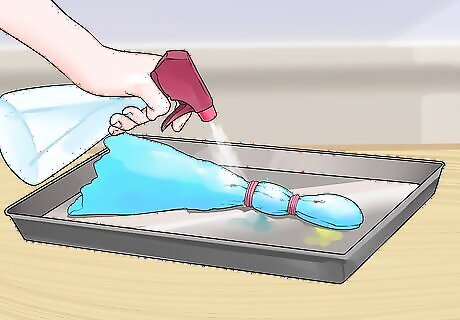
Apply the bleach to the shirt. Working over a sink or a deep aluminum tray, start squirting the bleach solution onto the shirt. Cover the entire shirt and get it as wet with the solution as possible.
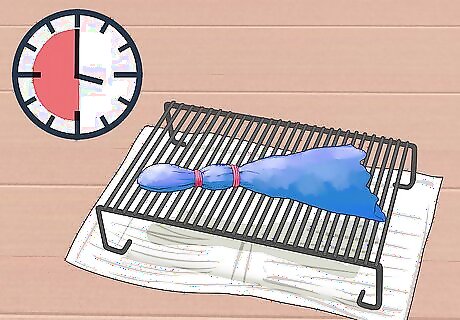
Let the bleach set. Place the shirt some place where it will not be disturbed, and let it sit for about 30 minutes. You can also use undiluted bleach instead, and apply it to the shirt at five minute intervals. The shirt will be bleached in about 10 to 15 minutes.
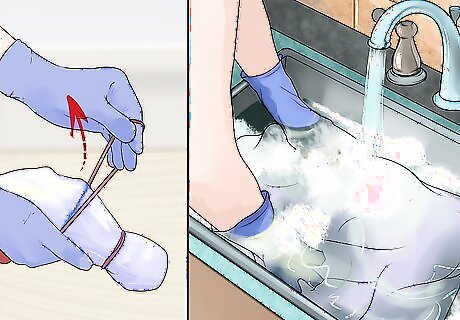
Remove the rubber bands and rinse. Once the shirt has bleached to your preference, remove the rubber bands and rinse the shirt under cool water. You may see some of the dye come out. Keep rinsing until the water starts to run clear. If you cannot take them off, because you wrapped them too tightly, you can cut them off using a pair of scissors. Be careful not to accidentally cut your shirt!
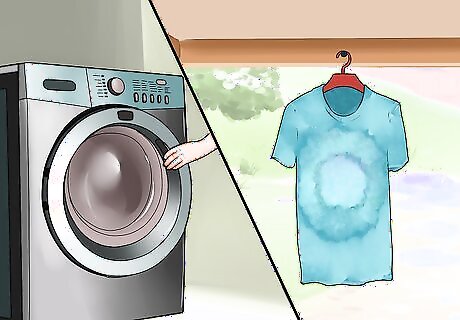
Dry the shirt. You can now either hang the shirt up to dry, or you can toss the shirt into the drier.
Using Sharpies to Dye Your Shirt
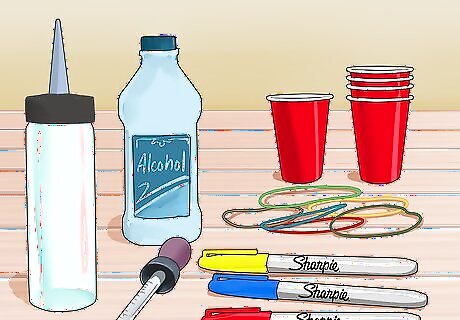
Consider tie-dyeing your shirt using Sharpies. While it might be a little more difficult to create large designs that cover the entire shirt using the Sharpie method, you can use this technique to create smaller designs, such as flowers and spirals. This section will teach you how to create smaller tie-dye designs using Sharpies and rubbing alcohol. You will need: Sharpie permanent markers in various colors (or one color if you so choose). Rubbing alcohol. An applicator bottle or an eye dropper. Rubber bands. Plastic cups.
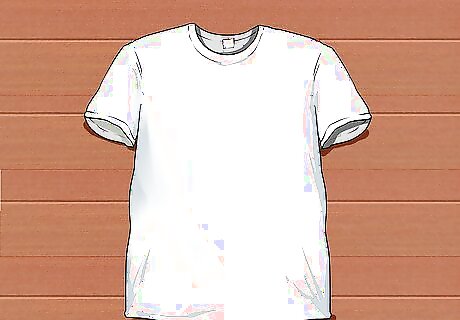
Start with a clean, white shirt. Because Sharpies are translucent, the color of your shirt will show throw. This means that if you draw with a yellow sharpie over a light blue shirt, you will get green. A white base, however, will give you the brightest, most vibrant results. Make sure that the shirt (or any other item you are using) is clean, as any dirt or oils may prevent the Sharpie inks from adhering properly.
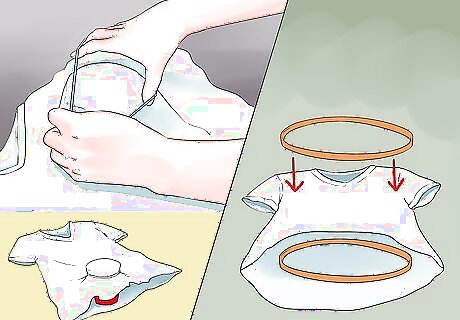
Insert a plastic cup inside your shirt and secure it with a rubber band. Decide where you want your first design to be, then place a plastic up inside the shirt. Pull the fabric taut over the rim of the cup. Secure it with a rubber band by stretching the band around the fabric and the cup. You are creating a sort of mini fabric-and-cup drum. You can also use an embroidery hoop instead of a plastic cup and a rubber band. Simply tuck the inner circle inside the shirt, and secure it by placing the outer circle over it and the shirt.
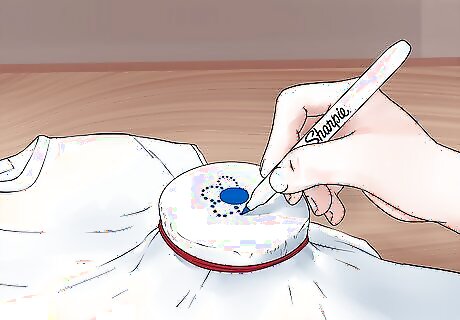
Start creating small rings and circles using dots. Press the tip of your Sharpie down onto the fabric, creating a small dot. Make the next dot no more than a centimeter away from the first one. Keep making dots until you have a complete circle or ring—you are essentially making a dotted line. You can make the dots as big or as small as you want, but they should not be touching. Be sure to work inside your cup. Here are some design ideas: You can create fireworks by making two circles, one inside the other. Use a different color for each circle. Create flowers by making one big dot, and then making a ring of smaller dots around it. These smaller dots will become petals.
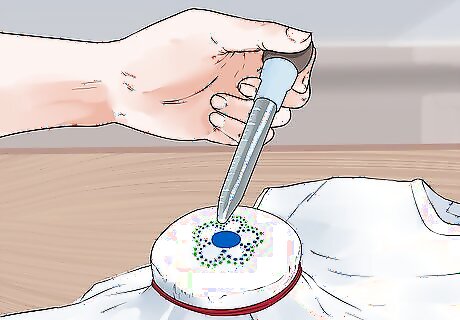
Drip the alcohol onto the design. Once you are satisfied with your design, you can start adding the rubbing alcohol. You can soak up some rubbing alcohol with an eyedropper and squeeze it onto your design. This will give you more control, and works best on smaller designs. You can also fill an applicator bottle with rubbing alcohol and drizzle the alcohol over the design. This will give you less control, but it is much faster and you won't have to refill as often. As you continue adding alcohol, the Sharpie inks will begin to dissolve and spread, resulting in a tie-dye effect.
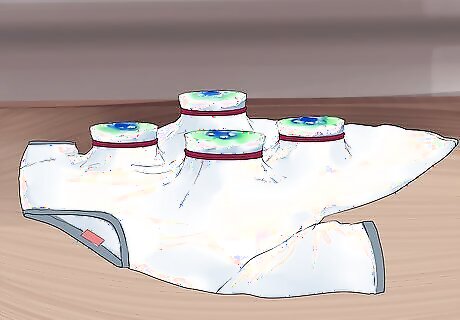
Let the shirt dry. Because you used rubbing alcohol, this should not take very long. Once the shirt is dry, take it off the cup.
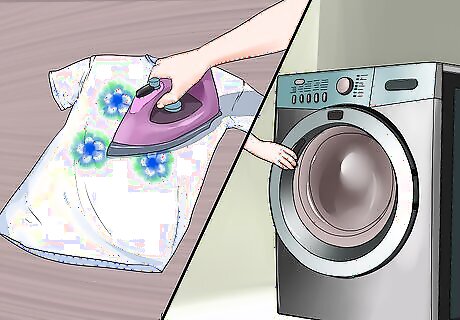
Set the design using heat. You can either toss the shirt into the drier (set to high) for 15 minutes, or you can simply iron the design for 5 minutes instead. If you are using an iron, find an adult to help you, and make sure that it is set to the highest temperature.
Using the Traditional Method to Dye Your Shirt
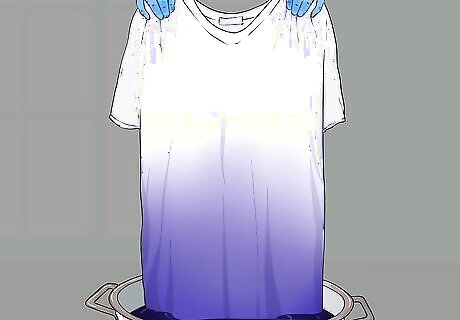
Consider using the traditional method. While the traditional method may take some extra effort, it is both fun and easy. If you use salt or vinegar in your dye bath, you will not have to let the dye sit for as long.
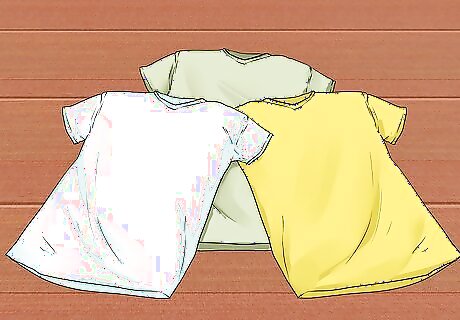
Find something white-colored to dye. Because clothing dyes are translucent, you will get the brightest and most vibrant colors if you use white-colored clothes. You can use other light colors, such as pastels, yellow, light tan, and light grey, but keep in mind that the original color will blend with the dye color. This means that if you try to tie-dye a yellow shirt blue, you will get green instead. Clothes made from cotton, linen, rayon, and wool work the best. Avoid, acrylic, metallic, polyester, and spandex fabrics, as they will not take dye as easily if at all. You can tie-dye almost anything, from T-shirts to pants and skirts to even baseball caps.
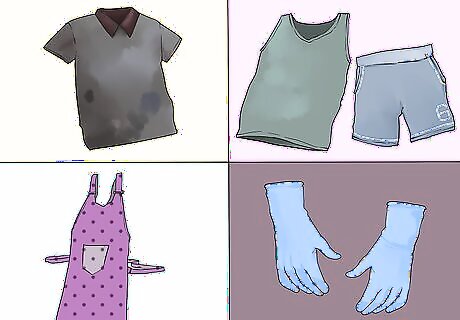
Wear protective clothing. Fabric dye may not only dye the white shirt you will be using, but it may also dye your clothes if you are not careful. It can also irritate your skin, or stain it for a few days. To protect both your clothes and skin, you will need to take some extra precautions. Here are some tips: Wear old clothes that you do not mind getting stained or dirty. Dark-colored clothes will hide dye stains better than light-colored clothes. If you do not have any old clothes to spare, then wear shorts, a sleeveless top, and an apron. Consider wearing some plastic gloves, such as the type you might use to wash dishes or dye your hair. You can also find plastic tie-dyeing clothes in the T-shirt and tie-dye section of an arts and crafts store.
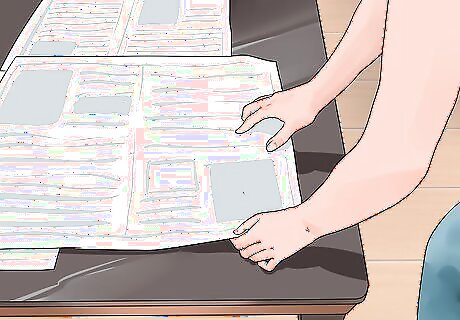
Protect your work area or work outdoors. Tie-dyeing can get messy, and while it is possible to clean up the worst of the stains using some rubbing alcohol, it is best to work outside. If you must work indoors, spread several layers of newspaper over your work area to protect it.
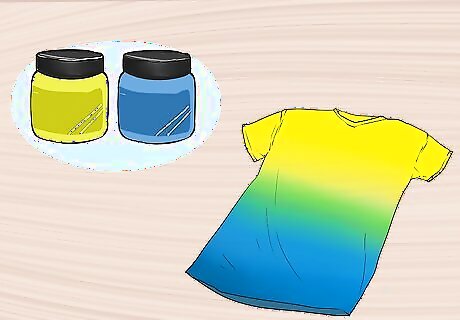
Decide how many and what colors you want your shirt to be. Most tie-dye shirts look best with two to three colors, and use either the primary colors (red, yellow, and blue) or the secondary colors (orange, green, and purple). How many colors you decide to use will determine how many buckets you will need. Each color will need its own bucket. You can find a variety of fabric dyes on Amazon.
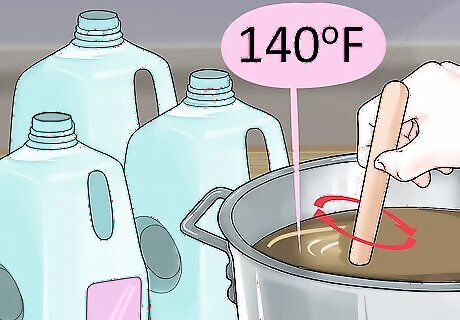
Prepare your dye baths. You can do this by willing a bucket with hot water, pouring in the dye, and stirring. The water will have to be at least 140°F (60°C). Most dyes will need to be diluted with hot water, and how much water will usually depend on the brand. In general, ½ cup (112.50 milliliters) of liquid dye requires 2 to 3 gallons (7.57 to 11.35 liters) of hot water. Most powder dyes need to be dissolved in 1 cup (225 milliliters) of hot water first, and then added to the 2 to 3 gallon dye bath.
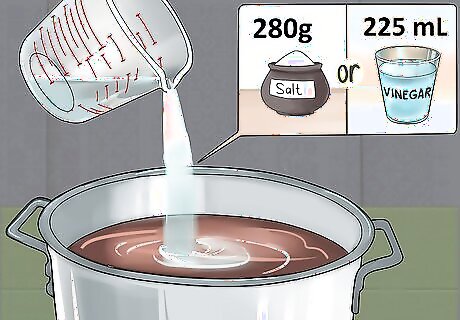
Consider adding salt or vinegar to the dye bath to help set the colors. While adding salt or vinegar to your dye bath may sound strange, adding one of these items will not only help the colors appear brighter and more vibrant, but it will also help "seal" them in and make them last longer. Once you have added the salt or vinegar, give your dye bath another stir to make sure everything is combined. Here is how you can use salt and vinegar in your dye bath: If your clothing is made out of cotton, linen, rayon, or ramie, add 1 cup (280 grams) salt for every 3 gallons (11.35 liters) of water. If your clothing is made out of nylon, silk, or wool, add 1 cup (225 milliliters) white vinegar for every 3 gallons (11.35 liters) of water.
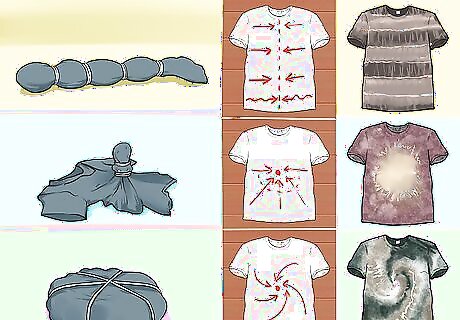
Tie rubber bands around the shirt. You can create different designs by wrapping rubber bands around your shirt in different ways. Here are some ideas: To get a striped pattern, fold your shirt up like a fan or accordion. You can fold it width-wise, length-wise, or diagonally. Wrap a rubber band around one end of your shirt, then wrap another rubber band two to three inches (5.08 to 7.62 centimeters) away from the first one. Keep doing this until you reach the other end of the shirt. You are creating something that looks like a rope. The sunburst is a circular, radiating design, with each ray being a different color. Pinch the middle of your shirt and pull it towards you. Wrap a rubber band around the end. Tie a second rubber band a little further down your shirt. You are creating something that look like a rope. To make a spiral, start by placing your shirt down on a flat surface. Pinch the middle of your shirt and twist it. Keep twisting until you have created something like looks like a cinnamon roll. Wrap a rubber band around the "bun." Then, wrap another rubber band, but this time in the opposite direction, making a cross shape. You can wrap more rubber bands around your bun, sectioning it like a pizza or cake.
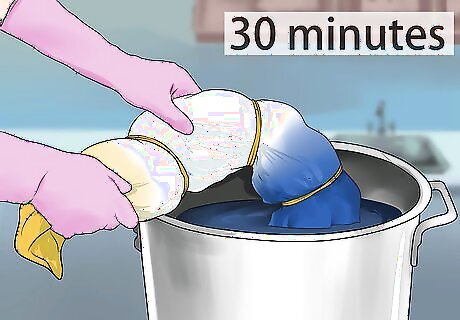
Start dyeing your shirt. Take your shirt and dip part of it into the dye bath. If you are using multiple colors, dip it into the lightest color first. Leave the shirt in dye bath for 4 to 10 minutes before taking it out. For a more intense color, leave the shirt in the bath for 30 minutes. If you are using multiple colors, rinse the freshly-dyed part of the shirt under cool water first to remove any excess dye. Squeeze the extra water out from the shirt, and dip it into the next color. The longer the shirt sits in the dye bath, the darker the color will become. If the water is too hot for you to handle, try wearing some dish washing gloves to protect your hands. You can also use a pair of chopsticks or tongs to move the shirt around instead.
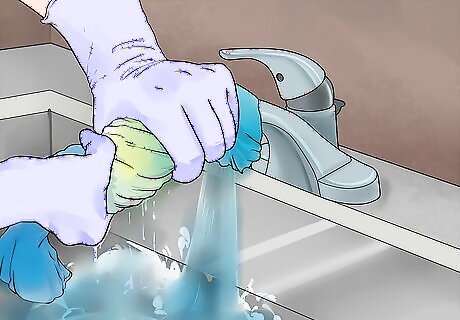
Rinse the shirt. Once you have dyed your shirt to your linking, you can snip the rubber bands off with a pair of scissors and rinse the shirt with cool water to get rid of any extra dye. Keep rinsing until the water starts to run clear. Squeeze the extra water out from the shirt.
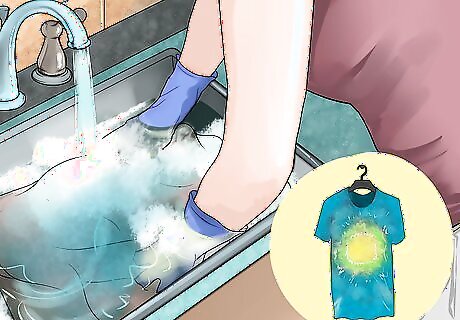
Hand wash the shirt and hang it up to dry. Wash the shirt using warm water and a gentle detergent. Rinse it out again using cool water, and hang it to dry. You can also toss the shirt into the drier.

















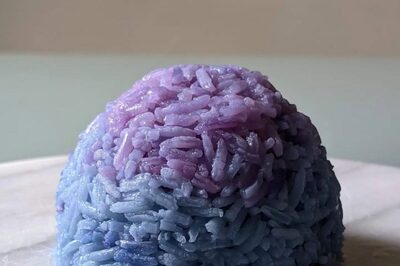

Comments
0 comment